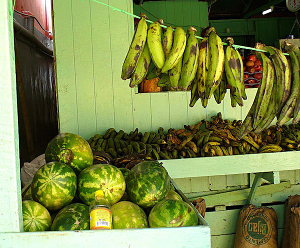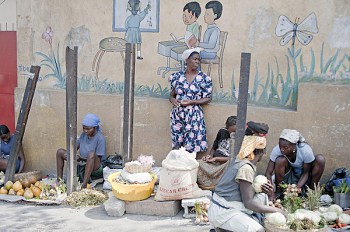This review on Food and Identity in the Caribbean is the first in a line of reviews from our „food“-list, curated by our review assistant Sophie Allies-Curtis. Sophie did a great job curating the list and coordinating the reviews. Due to other commitments, she decided to leave Allegra. We really enjoyed working with you, Sophie, and wish you all the best for your future!
Garth, Hanna (ed.). 2013. Food and Identity in the Caribbean. Bloomsbury Press. Paperback. ISBN: 9780857853592. 192 pp.
‘Food and Identity in the Caribbean’, edited by Hanna Garth, unites anthropologists in a common effort to address the issue of defining cultural borders and expressing identity through culinary practices, contributing as such to shedding light on an understudied topic that has only relatively recently been framed as a subject region. The stated purpose, emphasized by Richard Wilk‘s preface, is to take ‘a prosaic dish as a departure point in order to work outwards into larger issues’ (Will: ix), so that ultimately what seemed a peripheral trope for most of anthropology’s history is now considered a discipline that not only partakes in creating rich ethnographic data, but also leads the reader through stories of global inequality, slavery, migration, power relations, and social self-making strategies. Culinary habits stand at the base of our sociality, which explains their continuity throughout time: they are most often learned in the domestic space, in the early years of one’s life (Goody 1982: 151).
An ethnography focused on the Caribbean makes visible the negotiations that accompany both collective identities and individual subjectivity. The secret ingredient in the successful quest at stake is already suggested in the title: the fluidity of food translates its nature into the notion of identity.
 In addition to framing ‘identity’, and consequentially ‘culture’, as something born out of intersections, involving hierarchies and power relations, the vibrant ethnographies intimate towards debates on assimilation, creolization, and transculturation, advocating the legitimacy of the latter. Dishes, culinary behaviour, choice of ingredients and food staples, as well as production processes mirror the manifold ways in which ‘the culture mutation’ manifests itself. Just as there is no native point ‘upon which to lean’ (Trouillot as cited in Garth: 4), there is neither a singular, basic point underpinning a food system (Douglas 1997: 44). Rather, the meaning and content of each element establish themselves as intrinsic to the network of relations in which this one partakes, regardless if one speaks of a culinary repertoire, or of society’s dynamics.
In addition to framing ‘identity’, and consequentially ‘culture’, as something born out of intersections, involving hierarchies and power relations, the vibrant ethnographies intimate towards debates on assimilation, creolization, and transculturation, advocating the legitimacy of the latter. Dishes, culinary behaviour, choice of ingredients and food staples, as well as production processes mirror the manifold ways in which ‘the culture mutation’ manifests itself. Just as there is no native point ‘upon which to lean’ (Trouillot as cited in Garth: 4), there is neither a singular, basic point underpinning a food system (Douglas 1997: 44). Rather, the meaning and content of each element establish themselves as intrinsic to the network of relations in which this one partakes, regardless if one speaks of a culinary repertoire, or of society’s dynamics.
This book integrates the interplay between identity and food into a larger framework of analysis that argues not only for rethinking difference through connection, but moreover, that the world has actually always been linked together (Gupta and Ferguson 1992: 8).
If this concept is to stand for both awareness of the Other’s difference and the subsequent imperative into ‘rethinking one’s own ways of living and thinking’ (Garth: 3), then one of the central points around which the articles gravitate refers to the timely arrival of modernity in the Caribbean. Such acknowledgement of the Other’s otherness is entangled with a long history of oppression and class division, as well as with systematic economic exploitation. In some cases strong polarisation takes hold, as Ryan N. Schacht argues in the first chapter, and because difference quite often bears inequality, at least one actor in the picture is disadvantaged, namely the Makushi population in the particular case of Guyana. Hoping to achieve some day the prosperity pictured in the objectified (Bourdieu 1984) image of the more cosmopolitan part of the population, the Makushi enact their identity on a daily basis through their food staple cassava, holding as such a grip on their relatively old and common values. Early modernity may lead to a strong drive for neophilia, resulting in what looks like a ‘nutritional madness’ (Fischler 1980: 940): Lauren Wynne’s depiction of KFC as embodying Trini nationality points to a dramatic questioning of the very dichotomy foreign – local, centripedal – centrifugal.
There are more sides to the tension between the drive for novelty and the fear of losing one’s own identity through it, to which economic top-down measures applied on a large scale contribute. Hanna Garth’s chapter shows how, as access to ingredients necessary in the preparation of ‘traditional’ dishes has been limited in the last decades in Cuba, local notions of what counts as ‘Cuban’ food have been consciously expanded, whereby Cubans are able to continue consuming a specific cuisine, with a particular meaning attached to it. However, a sense of possession attached to former ‘traditional’ food versions is lost in this bottom-up strategy of preserving identity. Such coping mechanisms at the microlevel of everyday life do not always suffice for those facing the danger of losing a part of their identity. The introduction of improved seeds in Haiti poses a threat to local farmers both for economic reasons, rendering them unable to keep their relative independence, and ecological concerns, the outcomes of such a measure being partly harmful, partly unknown, and therefore risky. Identity must be defended along with economic autonomy by grass-root organizations in the face of humanitarian aid mechanisms that stand a chance of doing more harm than good, as John Mazzeo and Barrett P. Brenton make a strong case for in their contribution to this book.
 Stakes in preserving identity through food are high for the Caribbean both at home and in the diaspora. In her article on Honduras, Heather J. Sawyer clarifies ‘the staged aspect of tourism’ (MacCannell as cited by Sawyer: 46): while tourists consume the ‘authentic’ cuisine, the vast majority of local population is deprived of it precisely due to tourism development measures that made the once abundant free food now into a luxurious commodity. Forced into subsistence conditions, strategic memories enact and further preserve collective identities. When distance in time is intertwined with distance in space, not only nationhood is reproduced through food, but also its racial and gender components into which the Guyanese diaspora segment it to affirm boundaries, according to Gillian Richards-Greaves. It is memories of food-related experience that inform these borders.
Stakes in preserving identity through food are high for the Caribbean both at home and in the diaspora. In her article on Honduras, Heather J. Sawyer clarifies ‘the staged aspect of tourism’ (MacCannell as cited by Sawyer: 46): while tourists consume the ‘authentic’ cuisine, the vast majority of local population is deprived of it precisely due to tourism development measures that made the once abundant free food now into a luxurious commodity. Forced into subsistence conditions, strategic memories enact and further preserve collective identities. When distance in time is intertwined with distance in space, not only nationhood is reproduced through food, but also its racial and gender components into which the Guyanese diaspora segment it to affirm boundaries, according to Gillian Richards-Greaves. It is memories of food-related experience that inform these borders.
Additionally to functioning as a vector for resistance, food is also deployed in political choices.
Formerly a symbol associated with oppression, mangú, the dish consumed by slaves, now stands for survival and cultural affirmation for Dominicans, and hence the power of ‘commemorative vigilance’ (Bardensten as cited by Marte: 58), argues Lidia Marte. Lauren Wynne analyses another way of such everyday food activism by describing how some young women use their ‘access to new foods and related knowledge to challenge local hierarchies of expertise and ideologies of racial difference’ (Wynne: 31). Hence, culinary changes advance explicit interests towards change within the social stratification.
There are not only common points to be found in these analyses of identity expressed and enacted through food. Indeed, the compiling of different ethnographic accounts exploring identity through food-related topics constitutes a fair example of cooking up a successful collection of academic writings. The shared epistemological premise that looks at ‘identity’ as a relationship, instead of a property (Garth: 1) is explored in multifarious ways, revealing layers of globalization.
Despite leaving out many parts of the Caribbean, the book’s project is neither undermined, nor lacking in any respect. It plays well on the dynamics between wisely chosen general notions and the particular examples depicted so colourfully. The writing style makes it widely accessible not only to scholars within the field of anthropology and social sciences, but also to a wider range of possible readers outside academia, driven by a keen interest be it even only in the Caribbean, or in food.
Last, but not the least, the book might be of particular interest to those working within the feminist theoretical framework, due to a similar shift in the anthropology of food. Just as feminist anthropology analysed gender relations and gender as a structuring principle, a relatively new wave in food studies is dedicated to studying food-related identity relations as a border defining process. In the same way as the study of simply ‘gender’ might lead us at times on misleading paths, the prior study of food made us think in terms of individual cultures, with fixed identities. A problem of representation translates into a problem of visibility: the relational part of identities now affords an unobstructed view. Showing how neither gender nor other kinds of identity are inflexible is part of discovering the extent to which the world was always connected in terms of both material and immaterial items. I agree that trying out some Caribbean dishes sounds like a great start in this quest.
References:
Bourdieu, Pierre. 1984. Distinction. A Social Critique of the Judgement of Taste. Cambridge, MA: Harvard University Press.
Douglas, Marry. 1997. ‘Deciphering a Meal‘, in C. Counihan & P. Van Esterik. Food and Culture: A Reader. pp. 36-54. London: Routledge.
Fischler, Claude. 1980. Food Habits, Social Change and the Nature/ Culture Dilemma, in Social Science Information Vol. 19, No. 6, pp. 937-53.
Goody, Jack. 1982. ‘The High and the Low: Culinary Culture in Asia and Europe‘, in Cooking, Cuisine and Class: A Study in Comparative Sociology. Cambridge University Press.
Gupta, Akhil, and Ferguson, James. ‘Beyond “Culture”: Space, Identity, and the Politics of Difference‘, in Cultural Anthropology, Vol. 7, No. 1, pp. 6-23.




Good review. This book came out of several panels at the ASFS, including a packed section at 2010 conference in Bloomington, Indiana. It reflects the work of the panelists.